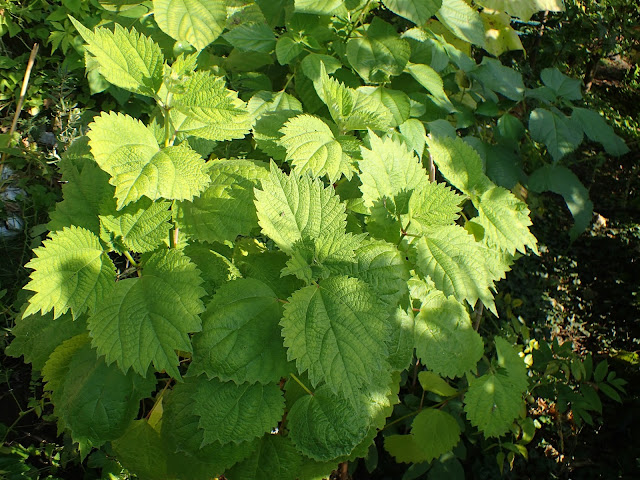To
the genus Boehmeria belongs about 47 species which grows both in Old and
New World. They are mostly perennial herbaceous plants (or shrubs), nettle
cousins, which are similar to nettles but have no stinging hairs. They are also
known under name “False nettles”. Some species are edible, but the most
important is use of them as textile plants. Especially one species – Boehmeria
nivea – called Ramie, is
widely cultivated w East Asia for high-quality fiber, which is used to make
ropes, cloth, and some industrial materials.
 |
| Boehmeria platanifolia (Sycamore-leaf False Nettle) - one of the most ornamental species |
They
can be easily propagated by seeds – sown surface (they do not need any
pre-treatment). They likes well drained soils and sunny or half-shade position.
Some species are full hardy in my 6b zone while other need to wintered in cool
cellar. Some species bloom late, so seeds not always ripe before winter in cool
climates.
I
tried to grow 9 species:
Ramie – Boehmeria
nivea var. nivea – this is subshrub to about 1,5m = 5ft tall with alternate leaves, native
to China, Bhutan, Cambodia, India, Indonesia, Japan, Korea, Laos, Nepal,
Sikkim, Thailand and Vietnam. I grew a strain from Japan. As I mentioned before
it is well known as textile plant and also vegetable (cooked roots and young
leaves). In zone 6b this species can survive mild winter but strong frosts
(during hard winters as occurs one for a few years) can kill it.
 |
| There are female flowers in upper part of stems and male ones below |
 |
| It started to flowering in end of August in first year from seeds |
Wild
Ramie, Japanese False Nettle – Boehmeria
nipononivea (syn. B. nivea var. nipononivea, B. nivea var. tenacissima) - very similar to
previous one perennial (subshrub) about 0,5-2,5m (=2-8ft) tall. They differs
mainly by their various hairiness. It is also used as textile and vegetable
herb. It is native to east Asia. I grew a form from Japan. Probably more frost
hardy than var. nivea (but I am not
sure because I wintered it only in cool cellar so far). Very ornamental.
 |
| It never flowered in my experience |
Giant
False Nettle - Boehmeria gigantea - rare something frost hardy perennial about 1,5m (=5ft) tall, Japanese
endemic. Very ornamental. As only one it has been evergreen in my cool and dark
cellar in winter 2017/18 (where was some frost).
 |
| It started to blooming very late in autumn |
Racemose
False Nettle - Boehmeria spicata - rare in cultivation Asiatic (sub-)shrub to about 1m (=3ft) tall. Hardy
to some frost (to about zone 7/8). Very ornamental. The young stems and leaf
petioles are red. Young leaves edible after cooking, very delicious.
 |
| One of the most ornamental species |
 |
| It started to blooming in September |
Long-racemose
False Nettle - Boehmeria longispica –dioecious subshrub to 1,2m(=4ft) tall, native to China and Japan. The leaves are large and almost suborbicular.
Used as vegetable (cooked roots and leaves).
 |
| This species has very large leaves |
 |
| and blooms late |
Sycamore-leaf
False Nettle, Plane-leaved False Nettle - Boehmeria
platanifolia – said
to be hardy
to zones 4-8) perennial to 1 m (= 3ft) tall, native to east Asia (China, Korea
and Japan). With very, very ornamental leaves.
 |
| Young plants |
 |
| It starts very late to blooming |
Three-pointed
False Nettle - Boehmeria tricuspis – a herbaceous, rather small perennial
0,5-0,8m (=2-3 ft) tall native to Japan and China. The leaves are lobed and very
ornamental. They are also edible after cooking.
 |
| Young seedling |
Siebold’s False Nettle - Boehmeria sieboldiana – erect
perennial about 1-2m (=3-6 ft) tall, native to Japan. Full frost hardy in zone
6b and warmer. Ornamental.
 |
| It is fully frost hardy in zone 6b |
American False Nettle, Bog Hemp - Boehmeria cylindrica –
this is herbaceous perennial or sub-shrub native to USA, Central and South
America. A fibers obtained from the stems is used for cordage, nets etc. It
survived a few winters in my garden in zone 6b (without mulching), but after
one very strong winter it died.
 |
| This spesies is less ornametal |
If you have available seeds of any rare nettle cousins
(species which belongs to family Urticaceae) please write to me.












































































